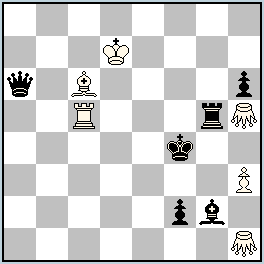|
|
Original Problems, Julia’s Fairies – 2014 (I): January – April →Previous ; →Next ; →List 2014(I) Please send your original fairy problems to: julia@juliasfairies.com |
No.507 by S. K. Balasubramanian – A nice Meredith with 3 pairs of thematic pieces! (JV)
Definitions:
Madrasi: Units, other than Kings, are paralysed when they attack each other. Paralysed units cannot move, capture or give check, their only power being that of causing paralysis.
Take & Make: Having captured, a unit must immediately, as part of its move, play a non-capturing move in imitation of the captured unit from the capture-square. If no such move is available, the capture is illegal. Promotion by capture occurs only when a pawn arrives on the promotion rank as the result of a take&make move. Checks are as in normal chess: after the notional capture of the checked K, the checking unit does not move away from the King’s square.
Grasshopper(G): Moves along Q-lines over another unit of either color to the square immediately beyond that unit. A capture may be made on arrival, but the hurdle is not affected.
|
No.507 S. K. Balasubramanian
India
original-03.03.2014
 h#2,5 2 solutions (6+6) h#2,5 2 solutions (6+6)Madrasi Take & Make Grasshoppers: h1, h5 Solutions: (click to show/hide)
|


 No.507
No.507 
Madrasi condition is used to force white grimshaw at d5. Neat! But it is a weakness that the mates will work without Madrasi as the BB/BR are pined anyway !
It really seems that Madrasi condition is not well justified. What do you think about the following version (with half a move less)?
[img]http://www.yacpdb.org/xfen/?4K3/3p4/2B4p/2R3r(Q2)/2p2k2/7P/6b1/7(Q2)[/img]
h#2
1.Bd5 Gf5 2.Kxf5(Kh5) Bxd5(Bf7)‡
1.Rd5 Gf3 2.Kxf3(Kh1) Rxd5(Rd1)‡
Of course, only Take&Make here (no Madrasi)
hm…… The mates are there. But I think main attraction of the matrix is the doubled release of paralysis.
I don’t want to argue whether Madrasi condition is justified or not. But as Seetharaman pointed out the main attraction is double release of Madrasi. Both the wR & wB are unmovable initially because of paralysis, but both were made to move in both the solutions.
Georgy’s example shows an idea of a perfect mechanism of medium complexity. T&M condition might be justified as necessary for that mechanism. The play itself shows no particular idea, because it is trivially motivated. Trivial motivations alone would not justify the condition.
bB/BR are respectively not needed in one of the respective mates in No.507, so the mechanism is not quite perfect. But it is still rather complex and perfectly used for the motivations of play which shows the main idea.
wB/wR will mutually unparalyse each other by Grimshaw but first they respectively must be unparalysed by a respective wG.
Madrasi is actually fully justified by the idea and T&M is mainly a tool for the efficiency of mechanism.
Thanks Nikola for the supportive comments for using Madrasi. I usually avoid unused pieces even if they are black. However, in this problem because the bR & bB are required for paralyzing their counterparts, their presence is difficult to be avoided unless they are forced to be eaten away, which of course I did not try.